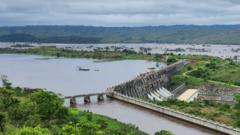As the Indian government embarks on an ambitious development plan known as the ‘Hong Kong-like’ project on the remote Great Nicobar Island, serious concerns arise regarding its implications for both the indigenous tribes and the fragile ecosystems of the region. The $9 billion initiative aims to create a transshipment harbor, airport, and new township, positioning the island as a strategic player in global trade. However, the project poses existential threats to local tribes, particularly the Shompen, and raises concerns about deforestation and ecological degradation.
### India's Controversial 'Hong Kong' Development on Great Nicobar Island Sparks Alarm

### India's Controversial 'Hong Kong' Development on Great Nicobar Island Sparks Alarm
India plans a multi-billion dollar development project on Great Nicobar Island, raising fears for indigenous tribes and the environment.
The federal initiative, budgeted at 720 billion rupees and spanning 166 square kilometers, aims to amplify trade routes vital to the Indian economy, particularly to counter China's growing influence. However, anthropologist Anice Justin and other experts warn that the project endangers the cultural heritage and survival of islanders dependent on their forest-rich environment. The Great Nicobar Island—home to rare flora and fauna and a variety of indigenous peoples—faces the irrevocable alteration of its ecosystems. Environmentalists also caution that the infrastructure developments risk long-term damage to marine life, particularly in vital nesting areas for endangered species like sea turtles. As the project unfolds over the next three decades, fears linger about its lasting impact on both local communities and the biodiversity of this ecologically sensitive region.





















